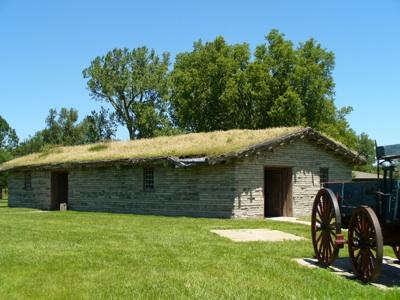Greetings from Fort Kearny (pronounced as Carney), the first and considered one of the most important military posts on the Oregon Trail. Following our stay at Rock Creek Station, we zigzagged 125 miles to the northwest following as closely as possible the Oregon Trail that itself traced a stretch of the Little Blue River.
Our goal was to spend time at Fort Kearny before following the Platte River to the town of North Platte, Nebraska, where we would stay for the night. Due to the time consumed in examining numerous historical markers, accompanied by blistering heat and a forecast for strong evening storms, we decided to skip tenting and spend the night in a motel in the town of Kearney.
Oddly, the town name is spelled differently than the fort. According to Alicia at the Fort Kearny State Historical Park visitor center, the difference stems from a mistake by the U.S. Post Office in naming the town.
Fort Kearny was initially built beside the Missouri River at what is now Nebraska City, but was moved west to offer better protection to the pioneers that by then were streaming west along the banks of the Platte River. Construction commenced in 1848 on the new Fort Kearny that became functional a year later. To view our video of Fort Kearny, visit this site.
The fort, laid out in a square, included a 4-acre parade ground. Buildings were initially constructed of sod with timber supports and earthen roofs. The fort was completed in time for the great masses of men migrating to the gold fields of California. Most of these men departed from St. Joseph, Missouri, and traveled along what was called the St. Joe Road.
Emigrants starting in Independence and St. Joseph moved along the Platte’s south bank, the same side on which Fort Kearny was located. Mormons departing mostly from Council Bluffs, Iowa, traveled along the north bank of the river.
Fort Kearny not only served to protect and offer supplies to the emigrants, but in later years included large stores that provided supplies to other forts along the trail.
Conflicts with Indians in the mid-1860s resulted in the building of a stockade that offered additional protection to the soldiers, emigrants, and livestock. Still later, the fort offer protection to employees of the railroad as they laid track that paralleled the trails. The fort was abandoned two years following completion of the railroad in 1869.
Although wagon ruts made by the pioneers are not visible here, Fort Kearny is a really pleasant place to visit. Lots of grass, many beautiful cottonwood trees, and a good visitor center.
It is such a nice day that we have decided to drive a couple of miles down the road and camp at neighboring Fort Kearny State Recreation Area. Tomorrow we follow the path of the Oregon Trail along the Platte River to the town of North Platte. It’s no more than 100 miles, but what’s the hurry?




Comments
Make sure you follow the trail at least as far as Scott's Bluff. It's a neat place.